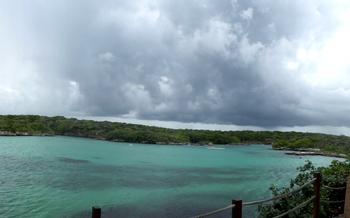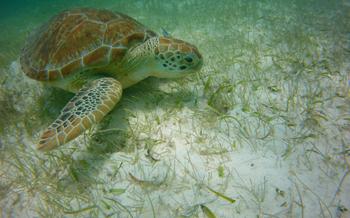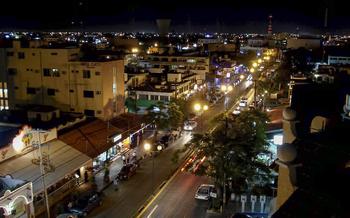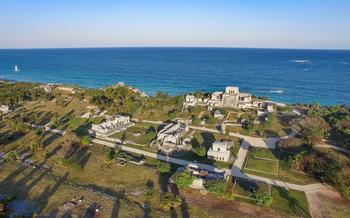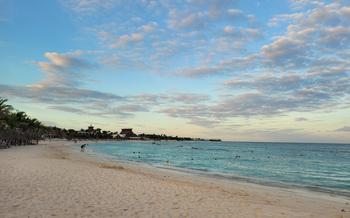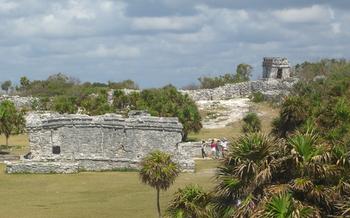
Tulum Monkey Sanctuary
- The Tulum Monkey Sanctuary: A Unique Eco-Friendly Experience
- Animal Encounters: Interacting with the Monkeys
- The Importance of Conservation: Supporting Monkey Sanctuary Initiatives
- A Safe Haven for Monkeys: Ensuring their Well-being
- Monkey Species at the Sanctuary: A Diverse Cast of Characters
- Educational Programs: Learning About Monkeys and Conservation
- Monkey Rescue and Rehabilitation: Giving Monkeys a Second Chance
- Volunteering Opportunities: Getting Involved in Conservation
- The Sanctuary's Natural Setting: A Tropical Paradise
- Family-Friendly Activities: A Fun Day Out for All Ages
- Photography Tips: Capturing the Essence of the Sanctuary
- Food and Refreshments: Dining Options at the Sanctuary
- Safety Precautions: Ensuring a Smooth and Enjoyable Visit
- Insider Tip: Enhancing Your Sanctuary Experience
The Tulum Monkey Sanctuary: A Unique Eco-Friendly Experience
In the heart of Tulum, Mexico, nestled amidst lush greenery and vibrant wildlife, lies the Tulum Monkey Sanctuary, a haven dedicated to the protection and rehabilitation of primates. Established in 2010, this non-profit organization has become a beacon of hope for endangered monkey species, offering visitors a rare opportunity to interact with these fascinating creatures in a safe and sustainable environment.
The Tulum Monkey Sanctuary operates under the core principles of conservation, education, and animal welfare. Its mission is to provide a natural habitat for rescued and rehabilitated monkeys, promote awareness about their conservation status, and inspire visitors to become advocates for wildlife protection. Through its various programs and initiatives, the sanctuary strives to create a positive impact on the lives of monkeys and contribute to the preservation of their natural habitats.
The sanctuary is home to several species of monkeys, including spider monkeys, howler monkeys, and capuchin monkeys. These primates were once victims of illegal pet trade, habitat loss, or injury, but now find refuge and expert care within the sanctuary's grounds. Visitors can observe the monkeys socializing, playing, and foraging in their natural surroundings, gaining a deeper understanding of their behaviors and the importance of their conservation.
Supporting conservation initiatives like the Tulum Monkey Sanctuary is crucial for the survival of endangered monkey species. By visiting the sanctuary, participating in educational programs, or making donations, individuals can directly contribute to the sanctuary's efforts to protect and rehabilitate monkeys. Every contribution, no matter how small, helps ensure a brighter future for these remarkable creatures.
Animal Encounters: Interacting with the Monkeys
Interacting with the monkeys at the Tulum Monkey Sanctuary is a unique and unforgettable experience. However, it's crucial to remember that these animals are wild creatures and should be treated with respect. Here are some essential guidelines:
Safety First: Always follow the instructions provided by the sanctuary staff. Maintain a safe distance from the monkeys and never attempt to touch or hold them.
Respectful Feeding: You can feed the monkeys with the provided food, but avoid offering them any human food or drinks. Improper feeding can harm their health and disrupt their natural diet.
Capture Memories: Take your time to capture memorable photos and videos of the monkeys. Be patient and wait for them to come close to you naturally.
Observe and Learn: Observe the monkeys' behavior without disturbing them. Respect their natural habitat and avoid making loud noises or sudden movements.
The Importance of Conservation: Supporting Monkey Sanctuary Initiatives
The Tulum Monkey Sanctuary is dedicated to protecting endangered monkey species and promoting sustainable practices. By supporting the sanctuary, visitors play a crucial role in ensuring the well-being of these amazing primates.
The Role of the Sanctuary in Protecting Endangered Species: - The sanctuary provides a safe habitat for endangered monkey species, allowing them to live and reproduce in a protected environment.
How the Sanctuary Contributes to Reforestation Efforts: - The sanctuary actively engages in reforestation projects, planting native trees and vegetation to restore the natural habitat of the monkeys.
The Impact of Visitor Contributions on the Sanctuary's Operations: - Visitor fees and donations directly contribute to the sanctuary's operational costs, enabling them to provide ongoing care for the monkeys.
Encouraging Responsible Tourism and Sustainable Practices: - By choosing to visit the sanctuary, tourists support responsible tourism practices that prioritize the well-being of the monkeys and their environment.
A Safe Haven for Monkeys: Ensuring their Well-being
The Tulum Monkey Sanctuary is dedicated to providing a safe and natural habitat for its rescued monkey residents. The sanctuary's spacious enclosures mimic the monkeys' natural environment, allowing them to roam freely and express their natural behaviors. Dedicated veterinarians and animal care specialists provide regular check-ups, ensuring the monkeys receive proper nutrition, medical attention, and enrichment activities to stimulate their minds and bodies.
The sanctuary also plays a crucial role in combating poaching and illegal wildlife trade. The staff actively collaborates with local authorities to prevent the capture and trafficking of monkeys, rescuing and rehabilitating victims of this cruel industry. By supporting the sanctuary, visitors directly contribute to the fight against wildlife crime and help protect these endangered species.
To ensure the monkeys' safety and well-being, visitors are required to follow strict guidelines while interacting with them. This includes maintaining a safe distance, avoiding sudden movements or loud noises, and refraining from touching or feeding the monkeys without permission from the sanctuary staff. By respecting these guidelines, visitors can help create a peaceful and stress-free environment for the monkeys, allowing them to thrive and flourish in their new home.
Monkey Species at the Sanctuary: A Diverse Cast of Characters
The Tulum Monkey Sanctuary is home to a diverse cast of monkey species, each with its own unique characteristics and behaviors. Visitors can encounter the playful spider monkeys, known for their long limbs and acrobatic movements through the trees. The sanctuary also houses howler monkeys, renowned for their loud calls that can be heard from miles away, serving as a form of communication between groups.
Capuchin monkeys are another common sight at the sanctuary, displaying their intelligence and dexterity as they forage for food and interact with visitors. The squirrel monkeys, with their small size and bushy tails, add a touch of charm to the sanctuary's inhabitants. Observing these diverse monkey species, visitors gain insights into the fascinating world of primates and their intricate social dynamics.
The sanctuary's commitment to conservation extends beyond providing a safe haven for these monkeys. Through educational programs and research initiatives, the sanctuary contributes to the preservation of monkey species in the wild, ensuring the survival of these remarkable creatures for generations to come.
Educational Programs: Learning About Monkeys and Conservation
The Tulum Monkey Sanctuary places great importance on educating visitors about monkeys, conservation, and the environment. To achieve this, the sanctuary offers a range of educational programs, including workshops, seminars, and guided tours. These programs are designed to provide visitors with in-depth knowledge about monkey behavior, ecology, and the importance of protecting their natural habitats.
During workshops, participants can engage in interactive activities and discussions led by experienced educators and primatologists. These workshops cover various topics, such as monkey communication, social dynamics, and the threats they face in the wild. Seminars, on the other hand, offer more formal presentations by experts in the field of primatology, providing visitors with the latest research and insights on monkey conservation.
Guided tours are an excellent way to learn about the sanctuary's specific efforts and the monkeys that reside there. Knowledgeable guides lead these tours, sharing fascinating information about the monkeys' behaviors, personalities, and the sanctuary's ongoing conservation projects. Through these educational programs, the Tulum Monkey Sanctuary aims to foster a deeper understanding and appreciation of monkeys and the importance of their conservation.
By participating in these educational programs, visitors not only gain valuable knowledge but also become advocates for wildlife protection. The sanctuary believes that education is a powerful tool for promoting conservation awareness and inspiring visitors to take action to protect monkeys and their habitats.
Monkey Rescue and Rehabilitation: Giving Monkeys a Second Chance
As a sanctuary dedicated to the well-being of monkeys, the Tulum Monkey Sanctuary plays a pivotal role in rescuing injured or orphaned primates and providing them with a second chance at life. The sanctuary's rescue team is equipped to respond to distress calls and retrieve monkeys in need, whether they have been victims of accidents, poaching, or illegal wildlife trade.
Upon arrival at the sanctuary, rescued monkeys receive immediate medical attention and care from veterinarians and animal care specialists. The sanctuary's team assesses their injuries, provides treatment, and monitors their progress closely. Once the monkeys have recovered their strength and health, the rehabilitation process begins.
Rehabilitation involves gradually reintroducing the monkeys to their natural environment and teaching them the skills they need to survive in the wild. This includes teaching them how to forage for food, interact with other monkeys, and avoid predators. The sanctuary's dedicated staff works closely with each monkey to ensure they are fully prepared for release back into the wild.
The journey to recovery for rescued monkeys can be challenging, but the sanctuary's team is committed to giving them the best possible care and support. By providing a safe haven and facilitating their rehabilitation, the Tulum Monkey Sanctuary offers these monkeys a chance to thrive and live a life free from harm.
Volunteering Opportunities: Getting Involved in Conservation
The Tulum Monkey Sanctuary offers a unique opportunity for individuals passionate about wildlife conservation to actively participate in its mission. The sanctuary's volunteer programs provide a hands-on experience, allowing participants to contribute directly to the well-being of the monkeys and the preservation of their natural habitat.
Roles and responsibilities of volunteers:
- Assisting with the daily care of the monkeys, including feeding, cleaning, and monitoring their health.
- Participating in enrichment activities designed to stimulate the monkeys' mental and physical well-being.
- Assisting with the rehabilitation of injured or orphaned monkeys, providing them with the necessary care and support.
- Conducting educational tours for visitors, sharing knowledge about the monkeys and the importance of conservation.
- Contributing to research projects and data collection, helping to advance the understanding of monkey behavior and ecology.
Benefits of volunteering:
- Gain hands-on experience working with monkeys and learning about their behavior, ecology, and conservation.
- Develop practical skills in animal care, wildlife rehabilitation, and conservation practices.
- Contribute directly to the sanctuary's efforts to protect and preserve monkey populations.
- Experience the unique opportunity to work in a tropical paradise surrounded by diverse wildlife.
- Meet like-minded individuals who share a passion for wildlife conservation and make lifelong connections.
How to apply for volunteer opportunities:
- Visit the sanctuary's website or contact them directly to inquire about volunteer opportunities.
- Complete a volunteer application form, providing information about your background, skills, and availability.
- Undergo an interview process to assess your suitability for the volunteer role.
- Commit to a minimum volunteer period, typically ranging from one week to several months, depending on your availability and the sanctuary's needs.
By volunteering at the Tulum Monkey Sanctuary, you become an integral part of its conservation efforts, contributing to the well-being of the monkeys and the preservation of their natural habitat.
The Sanctuary's Natural Setting: A Tropical Paradise
Located within the heart of the Riviera Maya, the Tulum Monkey Sanctuary boasts a stunning natural setting that complements the remarkable experience of interacting with monkeys. Surrounded by lush tropical vegetation, the sanctuary is a haven for diverse flora and fauna, offering visitors a glimpse into the vibrant ecosystem of the region.
The geographical location of the sanctuary plays a crucial role in its unique biodiversity. Situated in the transition zone between the tropical rainforest and the Caribbean Sea, the sanctuary features a diverse range of habitats, including mangrove forests, freshwater lagoons, and coastal dunes. This variety of ecosystems supports a wide array of plant and animal species, creating a rich tapestry of life.
The sanctuary's commitment to conservation extends beyond its primate inhabitants. It actively works to protect and preserve the delicate balance of the natural ecosystem. Visitors are encouraged to tread lightly and minimize their impact on the environment, ensuring that the sanctuary remains a safe haven for wildlife and a source of inspiration for future generations.
Family-Friendly Activities: A Fun Day Out for All Ages
The Tulum Monkey Sanctuary offers a range of activities that cater to both children and adults, making it an ideal destination for families. Kids can embark on an exciting journey of discovery as they learn about the sanctuary's monkeys and their unique characteristics. Interactive exhibits and educational games help them understand the importance of wildlife conservation and the role they can play in protecting these amazing creatures.
Families can participate in guided tours that provide insights into the monkeys' natural behaviors and habitats. Experienced guides share fascinating stories and anecdotes about the individual monkeys, making the tour both informative and entertaining. Children can ask questions and engage in discussions, fostering a deeper connection with the animals and the environment.
The sanctuary also offers a dedicated playground where kids can burn off energy and enjoy outdoor activities. Swings, slides, and climbing structures provide hours of fun while parents relax and supervise from nearby benches.
A visit to the Tulum Monkey Sanctuary promises a memorable and educational experience for the whole family. It's an opportunity to create lasting memories, foster a love for nature in children, and instill in them the importance of protecting our planet's biodiversity.
Photography Tips: Capturing the Essence of the Sanctuary
The Tulum Monkey Sanctuary offers ample opportunities for photography enthusiasts to capture stunning images of the monkeys and the surrounding natural beauty. Here are some tips to help you take amazing photographs:
-
Camera Settings: Choose a camera with a long lens (200mm or higher) to get close-up shots of the monkeys without disturbing them. A fast shutter speed (1/250s or faster) is recommended to freeze the monkeys' movements.
-
Capture Natural Behavior: Observe the monkeys and wait for moments when they are engaged in natural behaviors, such as grooming, playing, or interacting with each other. Patience is key to capturing these candid shots.
-
Composition: Pay attention to the background and composition of your shots. Incorporate elements of the sanctuary's lush vegetation or the stunning Caribbean Sea to create visually appealing images.
-
Ethical Considerations: Always prioritize the well-being of the monkeys. Avoid using flash photography, as it can be startling and disruptive to them. Respect the monkeys' personal space and maintain a safe distance.
Food and Refreshments: Dining Options at the Sanctuary
After exploring the sanctuary and interacting with the monkeys, you're bound to work up an appetite. Luckily, the Tulum Monkey Sanctuary offers various dining options to satisfy your cravings. Within the sanctuary grounds, you'll find restaurants and cafes serving a range of delicious dishes, including local specialties and international cuisine.
Indulge in the flavors of traditional Mexican cuisine at one of the on-site restaurants, where you can savor mouthwatering tacos, enchiladas, and other regional delicacies. For a lighter meal, grab a refreshing salad or a flavorful sandwich at one of the cafes. Vegetarian and vegan options are also available to cater to different dietary preferences.
To quench your thirst, stay hydrated with fresh juices, bottled water, or a variety of soft drinks available at the sanctuary's cafes. Remember to support local businesses by choosing local produce and products whenever possible. Your dining choices not only provide sustenance but also contribute to the community's economic development.
Safety Precautions: Ensuring a Smooth and Enjoyable Visit
The Tulum Monkey Sanctuary prioritizes the safety and well-being of both its visitors and the monkeys. To ensure a smooth and enjoyable experience for all, it's essential to adhere to the sanctuary's safety guidelines and regulations. These guidelines are designed to minimize risks and create a harmonious environment for everyone.
Respecting the sanctuary's staff and other visitors is paramount. The staff is dedicated to providing a safe and educational experience for all, so it's important to follow their instructions and guidance. Additionally, being mindful of other visitors' space and experience enhances everyone's enjoyment.
Travel insurance is highly recommended for peace of mind during your visit. It provides coverage for unexpected events such as medical emergencies, lost luggage, or trip cancellations. Having travel insurance ensures that you're protected against potential financial losses or unforeseen circumstances.
By following these safety precautions, you can contribute to a positive and responsible visit to the Tulum Monkey Sanctuary, ensuring a safe and enjoyable experience for yourself, the monkeys, and fellow visitors.
Insider Tip: Enhancing Your Sanctuary Experience
Aspect 1: Best time of day to visit for optimal monkey sightings.
Plan your visit to the Tulum Monkey Sanctuary for the early morning or late afternoon hours. During these times, the monkeys are most active, and you'll have the best chance of spotting them foraging, playing, or socializing in the trees.
Aspect 2: Recommended duration of your visit to fully explore the sanctuary.
Allocate at least two to three hours for your visit to the sanctuary. This will give you ample time to walk through the different enclosures, observe the monkeys, and participate in any educational activities or guided tours that may be offered.
Aspect 3: Tips for capturing unique and memorable moments with the monkeys.
Be patient and observant when photographing or filming the monkeys. Avoid sudden movements or loud noises that might startle them. Use a telephoto lens to capture close-up shots while maintaining a respectful distance.
Aspect 4: Additional resources and websites for further information and planning.
For more information on the Tulum Monkey Sanctuary, visit their official website or check out reputable travel blogs and online forums for firsthand accounts and tips from other visitors.


